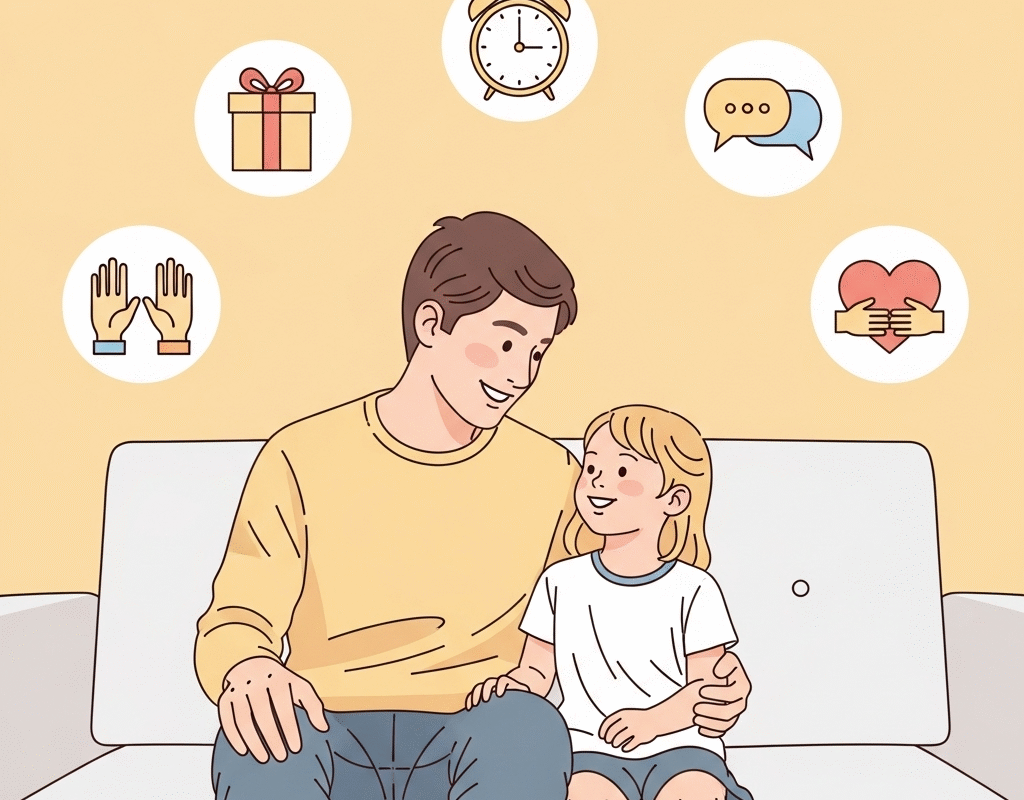Love Languages in Parent-Child Relationships: Building Connection Across Generations (2025)

Love Languages in Parent-Child Relationships (2025)
Introduction
“My teenager barely talks to me anymore, but I buy them everything they want. I don’t understand why we feel so disconnected.”
If this sounds familiar, you’re not alone. Many parents pour love into their children through gifts, lectures about their future, or constant doing for them—only to feel like their efforts go unnoticed or unappreciated. The issue isn’t that you don’t love your child enough. It’s that you might be speaking different love languages.
While most people think of love languages as something that applies only to romantic relationships, they’re equally powerful in parent-child dynamics. Understanding how your child receives love—and how you naturally express it—can transform your relationship and create the deep connection you’re both craving.
Understanding Love Languages in Family Dynamics
The five love languages work differently in parent-child relationships than they do between romantic partners. Children can’t reciprocate love in the same way adults do, and their developmental stage dramatically affects both how they express and receive affection.
Key differences in parent-child love languages:
- Power dynamics matter: Parents have the responsibility to learn and adapt to their child’s language, not the other way around
- Development affects expression: A toddler’s quality time looks very different from a teenager’s
- Security builds first: Children need to feel safe and secure before they can fully receive love in their preferred language
- Multiple languages often apply: Children may need different love languages for different emotional needs
How to Identify Your Child’s Love Language

Unlike adults who can take a quiz or have a conversation about their preferences, identifying a child’s love language requires careful observation. Here’s what to watch for:
Observe How They Naturally Express Love
Children often give love in the way they most want to receive it:
- Words of Affirmation: They frequently compliment you, ask “Did I do good?”, or say “I love you” spontaneously
- Quality Time: They follow you around the house, want to help with everything, or ask you to watch them do activities
- Physical Touch: They’re naturally cuddly, sit close to you, hold your hand, or climb into your lap
- Acts of Service: They want to help you, make you drawings or crafts, or do things “for” you
- Receiving Gifts: They bring you flowers from the yard, make you presents, or are always giving you little things they find
Notice What They Request Most Often
Pay attention to what your child asks for repeatedly:
- “Will you read to me?” (Quality Time)
- “Did you see what I made?” (Words of Affirmation)
- “Can I have a hug?” (Physical Touch)
- “Will you help me with this?” (Acts of Service)
- “Can we get this?” (Receiving Gifts)
Watch Their Response to Different Types of Love
Try expressing love in different ways and notice which ones light them up versus which ones they seem indifferent to. A child whose love language is quality time will be much more excited about a special one-on-one outing than about a new toy.
Love Languages by Age: What Changes and What Stays the Same
Toddlers and Preschoolers (Ages 2-5)

Primary needs: Security, routine, and simple expressions of love
- Use simple, specific praise: “You put on your shoes all by yourself!”
- Avoid complex explanations; focus on “I love you” and “You’re special to me”
- Narrate positive behaviors: “You’re being so gentle with the cat”
Quality Time:
- Get down to their eye level during conversations
- Follow their lead in play—let them direct the activity
- Create simple rituals like bedtime stories or morning snuggles
Physical Touch:
- Offer plenty of hugs, but respect their “no” if they’re not in the mood
- Hold hands during walks, give piggyback rides, snuggle during story time
- Use gentle touch during caregiving (brushing hair, applying sunscreen)
Acts of Service:
- Help them with tasks that are genuinely difficult for their age
- Anticipate their needs during stressful times (hunger, tiredness)
- Make their environment comfortable and safe
Receiving Gifts:
- Small, thoughtful items work better than expensive toys
- “Gifts” can be special snacks, stickers, or even flowers from the garden
- Present gifts with enthusiasm but without expecting specific reactions
School Age (Ages 6-11)

Primary needs: Encouragement, skill-building support, and belonging
Words of Affirmation:
- Focus on effort over outcome: “You worked really hard on that math problem”
- Acknowledge their growing independence: “I noticed you remembered to feed the dog without being asked”
- Be specific about character traits: “You showed real kindness to your sister today”
Quality Time:
- Engage in their interests, even if they’re not your favorite activities
- Have car conversations—many kids open up during drives
- Create special traditions together (weekend breakfast, evening walks)
Physical Touch:
- Respect their growing need for autonomy while still offering affection
- High-fives, fist bumps, and side hugs may feel more appropriate than full hugs
- Physical comfort during difficult moments (illness, disappointment)
Acts of Service:
- Help with homework organization rather than doing it for them
- Prepare their favorite snack after a hard day
- Drive them to activities they care about, even when it’s inconvenient
Receiving Gifts:
- Books, art supplies, or items related to their current interests
- Experience gifts like movie tickets or museum passes
- Small surprises that show you pay attention to what they like
Teenagers (Ages 12-18)

Primary needs: Respect, autonomy, and unconditional love despite changing behavior
Words of Affirmation:
- Acknowledge their growing maturity: “I can see how thoughtfully you handled that situation”
- Express confidence in their abilities: “I trust you to make good decisions”
- Be patient when they don’t immediately respond—they still hear you
Quality Time:
- Let them choose the activity sometimes, even if it’s just driving them somewhere
- Be available without being intrusive—parallel activities work well
- Share your own stories and experiences without making it about lessons
Physical Touch:
- Respect their boundaries completely—some teens need space, others still want hugs
- Quick shoulder squeezes or high-fives may feel less invasive
- Don’t take physical distance personally; it’s often developmental
Acts of Service:
- Support their independence by teaching life skills
- Help with college applications, job searches, or other “adult” tasks
- Keep their favorite foods in the house without making a big deal about it
Receiving Gifts:
- Money for things they want (within reason) can be meaningful
- Items that support their identity (band t-shirts, art supplies, sports equipment)
- Experiences that align with their growing independence
When Parent and Child Have Different Love Languages

It’s common for parents and children to have different primary love languages, which can lead to missed connections. Here’s how to bridge the gap:
If You’re a Words Parent with a Physical Touch Child
Your instinct: Praise them verbally, tell them you’re proud Their need: Hugs, snuggles, high-fives, gentle touches
Bridge strategy: Combine both by giving physical affection while offering praise. Instead of just saying “Great job,” give them a hug while you say it.
If You’re a Gifts Parent with a Quality Time Child
Your instinct: Buy them things to show you care Their need: Your undivided attention and presence
Bridge strategy: Give the gift of experiences rather than objects. Instead of buying a new game, spend time playing games together.
If You’re an Acts of Service Parent with a Words Child
Your instinct: Show love by doing things for them Their need: Verbal acknowledgment and encouragement
Bridge strategy: Narrate your service. Instead of silently packing their lunch, say “I’m making your favorite sandwich because I want your day to be great.”
Common Challenges and Solutions
“My child doesn’t seem to appreciate anything I do”
Possible issue: You’re speaking your own love language instead of theirs
Solution: Step back and observe what makes your child light up. Experiment with different approaches for a week each and notice the difference in their response.
“My teenager says they don’t want affection anymore”
Possible issue: Their love language expression is changing with development, not disappearing
Solution: Ask how they’d like to receive love now. Many teens still want connection but in different forms—maybe it’s quality time in the car or acts of service like respecting their privacy.
“I have multiple children with different love languages”
Possible issue: Trying to love all children the same way
Solution: Individualize your approach while maintaining fairness. One child might need extra hugs while another needs words of encouragement. Both are getting what they need, just in different forms.
“My child’s love language is gifts, but I don’t want to spoil them”
Possible issue: Misunderstanding what gifts mean to a gifts child
Solution: Focus on thoughtfulness over expense. A child whose love language is receiving gifts feels loved when they know you thought of them—this could be a special rock you found, their favorite snack, or a book about their current interest. Set clear boundaries about expensive items while still honoring their need to feel thought of.
Building Emotional Security Through Love Languages
Remember that love languages work best when children already feel secure and safe. Before focusing on specific love languages:
Ensure basic needs are met: Food, shelter, safety, and routine come first
Maintain consistency: Children need to know what to expect from you
Practice emotional regulation: Children learn how to handle emotions by watching you handle yours
Set appropriate boundaries: Love languages aren’t about giving children everything they want; they’re about helping them feel genuinely loved within healthy limits
Creating Family Love Language Awareness
As children get older, you can begin to involve them in understanding love languages as a family:
Ages 8+: Explain the concept simply and help them identify their own and others’ love languages
Ages 12+: Have family discussions about how each person likes to receive love and how to show love to others
All ages: Model speaking others’ love languages, not just your own
When to Seek Additional Support
While love languages can dramatically improve parent-child relationships, they’re not a cure for everything. Consider professional support if:
- Your child shows signs of depression, anxiety, or other mental health concerns
- There are ongoing behavioral issues that don’t improve with connection
- Your family has experienced trauma or significant stress
- You’re struggling with your own emotional regulation as a parent
Moving Forward: Small Changes, Big Impact
Understanding your child’s love language doesn’t require a complete parenting overhaul. Start with small, consistent changes:
- Observe your child this week and notice what makes them light up
- Experiment with one new way of showing love in their preferred language each day
- Be patient with yourself and your child as you both adjust to new patterns
- Stay consistent even when you don’t see immediate results
Remember, the goal isn’t perfection—it’s connection. Children need to feel genuinely seen, understood, and loved for who they are. When you speak their love language, you’re telling them that not only do you love them, but you’ve taken the time to understand how they best receive that love.
The parent-child relationship is one of the most important foundations in a child’s life. By learning to speak your child’s love language, you’re giving them a gift that will impact every relationship they have in the future—the knowledge that they are worthy of being understood and loved exactly as they are.
Ready to discover your own love language? Take our comprehensive love language quiz to better understand how you give and receive love, which can help you connect more authentically with your child.
Want to learn more? Explore our complete guides to each love language:


Leave a Reply